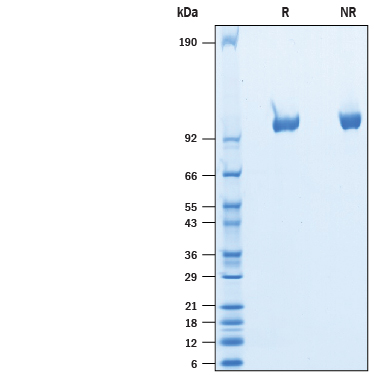Recombinant Rat Tie-2 His-tag Protein, CF Summary
Product Specifications
Ala23-Leu743, with a C-terminal 6-His tag
Analysis
Product Datasheets
Carrier Free
CF stands for Carrier Free (CF). We typically add Bovine Serum Albumin (BSA) as a carrier protein to our recombinant proteins. Adding a carrier protein enhances protein stability, increases shelf-life, and allows the recombinant protein to be stored at a more dilute concentration. The carrier free version does not contain BSA.
In general, we advise purchasing the recombinant protein with BSA for use in cell or tissue culture, or as an ELISA standard. In contrast, the carrier free protein is recommended for applications, in which the presence of BSA could interfere.
10458-T2
| Formulation | Lyophilized from a 0.2 μm filtered solution in PBS. |
| Reconstitution | Reconstitute at 500 μg/mL in PBS. |
| Shipping | The product is shipped at ambient temperature. Upon receipt, store it immediately at the temperature recommended below. |
| Stability & Storage: | Use a manual defrost freezer and avoid repeated freeze-thaw cycles.
|
Scientific Data
 View Larger
View Larger
 View Larger
View Larger
2 μg/lane of Recombinant Rat Tie-2 His-tag Protein (Catalog # 10458-T2) was resolved with SDS-PAGE under reducing (R) and non-reducing (NR) conditions and visualized by Coomassie® Blue staining, showing bands at 95-108 kDa.
Reconstitution Calculator
Background: Tie-2
Tie-2, also known as Tek, is a 145 kDa, type I transmembrane glycoprotein receptor tyrosine kinase that is a receptor for angiopoietins (1). The 1120 amino acid (aa) rat Tie-2 precursor contains an 18 aa signal sequence, a 723 aa extracellular domain (ECD), a 25 aa transmembrane segment, and a 354 aa cytoplasmic tail (2). The ECD contains two C2 Ig-like domains, three EGF-like motifs, and three fibronectin type III repeats. The cytoplasmic region has a split tyrosine kinase domain and presumably autophosphorylates as a ligand-induced homodimer (3). Rat Tie-2 ECD shares 96%, 90% and 89% aa identity with mouse, human and bovine Tie-2, respectively, and 47% aa identity with rat Tie-1 ECD. Cells known to express Tie-2 include embryonic and adult endothelial cells, hematopoietic stem cells and a circulating population of proangiogenic Tie-2 expressing monocytes (TEM) (4-7). A soluble form of Tie-2, most likely the result of proteolytic cleavage, is found in serum (8). The four angiopoietins are ligands of Tie-2. Ang-1 and Ang-4 are Tie-2 activators, while Ang-2 and Ang-3 can be activators or inhibitors, depending on context (1, 9). Tie-2 is said to be important for maintaining vascular integrity. It mediates endothelial cell-smooth muscle cell communication, and inhibits endothelial cell apoptosis, thus maintaining endothelial cell survival (10-12). It is also absolutely required for embryonic development of the endocardium (3, 10, 13). While not essential for embryonic hematopoiesis, Ang-1 production by osteoblasts promotes quiescence of Tie-2-expressing bone marrow stem cells. This quiescence is critical for maintaining an ongoing hematopoietic capability (12, 14, 15).
- Eklund, L. and B. R. Olsen (2006) Exp. Cell Res. 312:630.
- Maisonpierre, P.C. et al. (1993) Oncogene 8:1631.
- Vikkula, M. et al. (1996) Cell 87:1181.
- Asahara, T. et al. (1997) Science 275:964.
- Dallabrida, S.M. et al. (2003) Biochem. Biophys. Res. Commun. 311:563.
- Takakura, N. et al. (1998) Immunity 9:677.
- DePalma, M. et al. (2005) Cancer Cell 8:211.
- Reusch, P. et al. (2001) Angiogenesis 4:123.
- Lee, H.J. et al. (2004) FASEB J. 18:1200.
- Jones, N. et al. (2001) EMBO Rep. 2:438.
- Wong, A. L. et al. (1997) Circ. Res. 81:567.
- Hamaguchi, I. et al. (2006) Blood 107:1207.
- Puri, M.C. et al. (1999) Development 126:4569.
- Puri, M.C. and A. Bernstein (2003) Proc. Natl. Acad. Sci. USA 100:12753.
- Arai, F. et al. (2004) Cell 118:149.
FAQs
No product specific FAQs exist for this product, however you may
View all Proteins and Enzyme FAQsReviews for Recombinant Rat Tie-2 His-tag Protein, CF
There are currently no reviews for this product. Be the first to review Recombinant Rat Tie-2 His-tag Protein, CF and earn rewards!
Have you used Recombinant Rat Tie-2 His-tag Protein, CF?
Submit a review and receive an Amazon gift card.
$25/€18/£15/$25CAN/¥75 Yuan/¥1250 Yen for a review with an image
$10/€7/£6/$10 CAD/¥70 Yuan/¥1110 Yen for a review without an image


